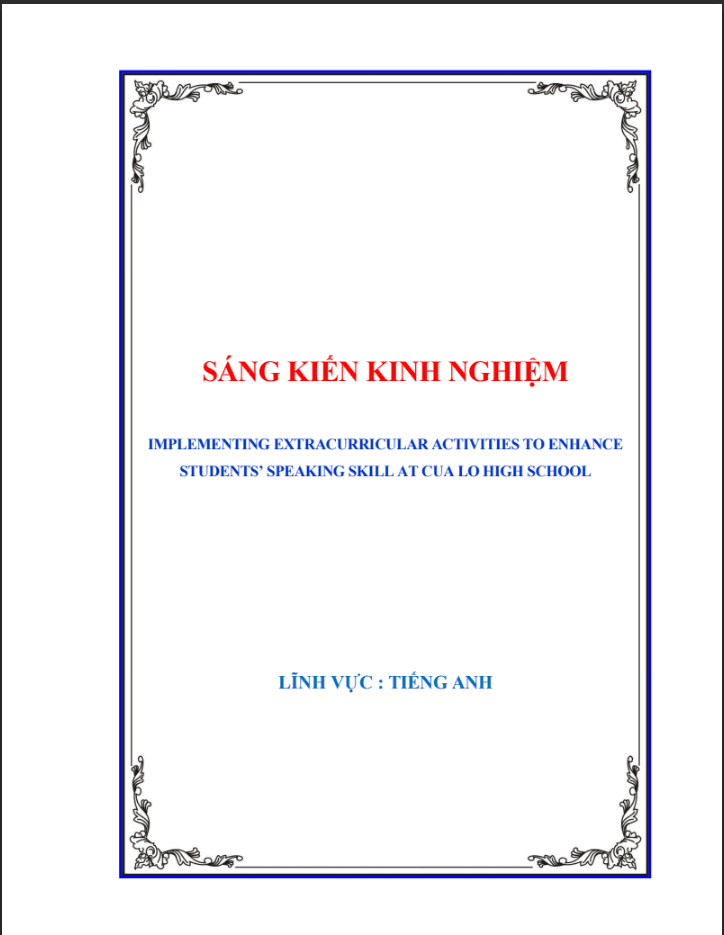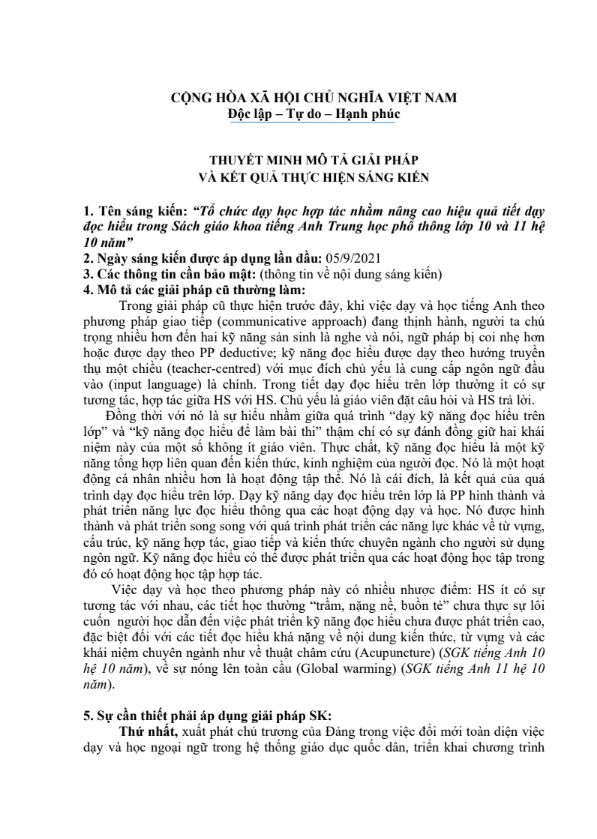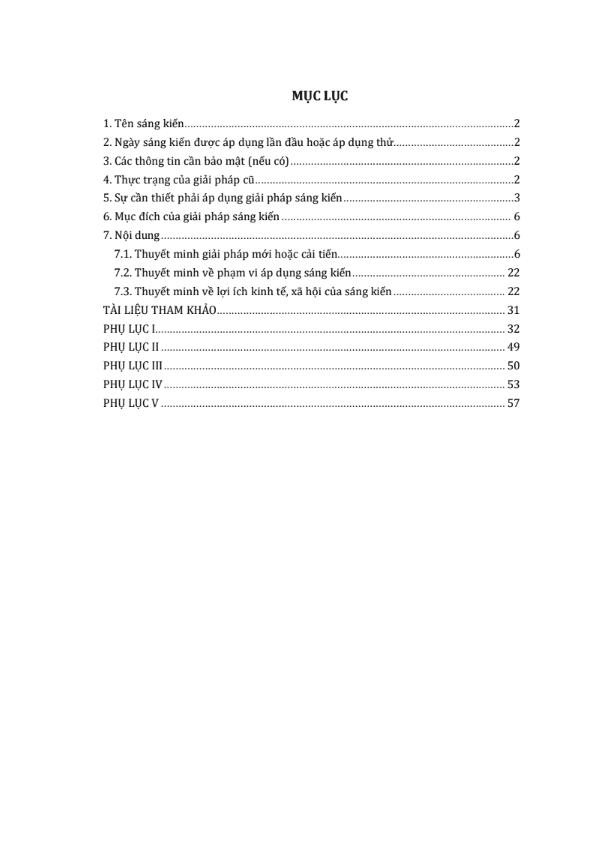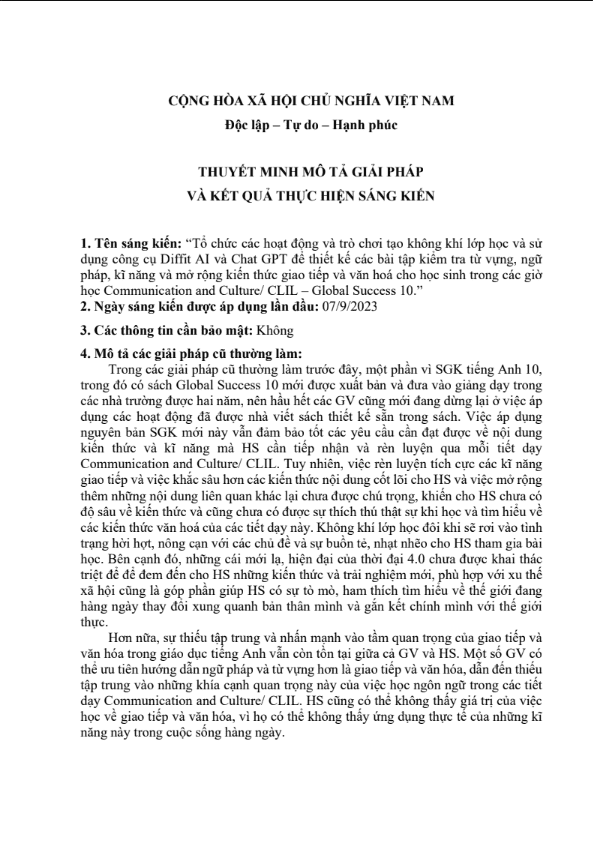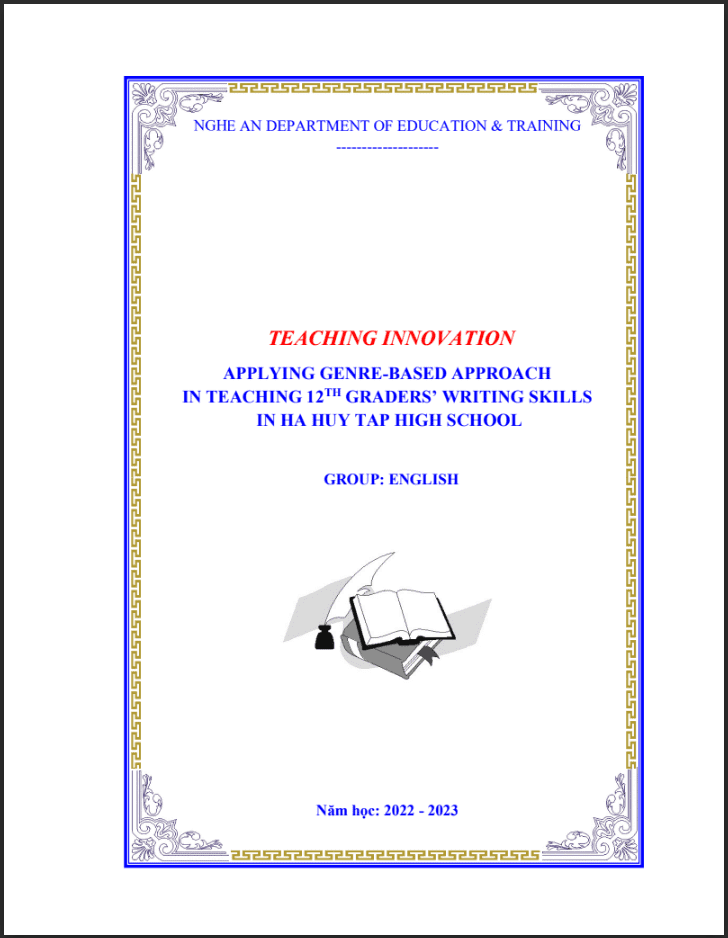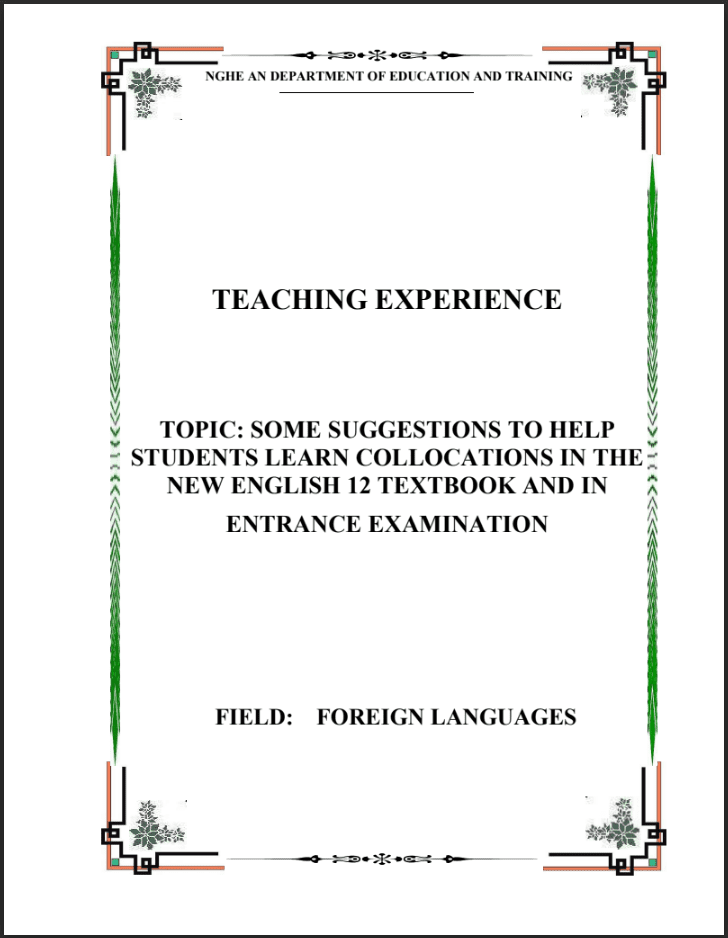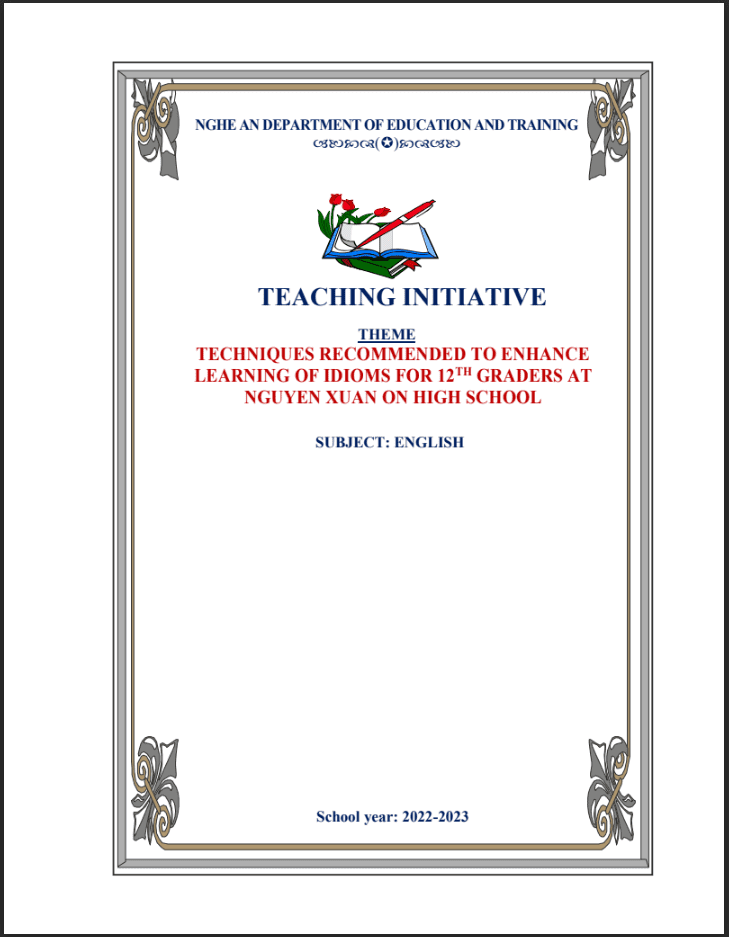SKKN Implementing extracurricular activities to enhance students’ speaking skill at high school
- Mã tài liệu: MP0109 Copy
| Môn: | Tiếng Anh |
| Lớp: | |
| Bộ sách: | |
| Lượt xem: | 439 |
| Lượt tải: | 1 |
| Số trang: | |
| Tác giả: | Đặng Thị Bảo Linh |
| Trình độ chuyên môn: | Thạc sĩ giáo dục |
| Đơn vị công tác: | THPT Cửa Lò |
| Năm viết: | 2022-2023 |
| Số trang: | |
| Tác giả: | Đặng Thị Bảo Linh |
| Trình độ chuyên môn: | Thạc sĩ giáo dục |
| Đơn vị công tác: | THPT Cửa Lò |
| Năm viết: | 2022-2023 |
Sáng kiến kinh nghiệm “Implementing extracurricular activities to enhance students’ speaking skill at high school”triển khai gồm các biện pháp nổi bật sau:
Mô tả sản phẩm
PART I: INTRODUCTION
1
.1. Reason for choosing the topic
In recent years, English teaching plays a vital role in the period of
modernization and industrialization. English has been one of the most important
subjects at school. For the educational innovation, many considerable changes in
teaching and learning English at high schools in Vietnam have been made. In oder
to develop students’ communicative competence, the emphasis of English teaching
has been placed on the mastery of communicative language skills in which four
language skills including listening, speaking, reading and writing have been given
balanced weight in the national syllabus.
However, the quality and effectiveness of teaching and learning English in
many high schools in Vietnam in general and in Nghe An in particular, are not really
as good and high as expected , especially, teaching speaking English skill in upper
secondary school is a really big challenge for most teachers as it is not easy at all for
the teachers to grow the students’ interest in order that they have motivation to speak
English. In reality, Vietnamese students find it hard to be able to communicate in
English fluently. One reason is that teachers have not frequently created a suitable
communication environment for students to learn speaking skill. Most teachers rely
basically on the textbook and do not spend time designing a variety of interesting
activities. Learning English is to communicate; nevertheless, in speaking lessons
students are usually passive, write most of the time or keep silent and after speaking
lessons, students do not know how to express their ideas in real situations related the
topic they have learned in class.
As teachers of English, we find out that sometimes it can be difficult to keep
our students on task in four walls of the classroom . Therefore, we always try to look
for the most effective ways of teaching so that our students can understand the lesson
easily and love learning English. We have applied a variety of different ways of
teaching related using teaching aids and other technologies. Among those, the most
effective method that allows our students to participate in is extracurricular activities
since students can relax and learn the language at the same time without much
pressure of studying. In the recent years we have applied many extracurricular
activities at our school on a large scale and we have found that our students have
studied more actively and effectively. They are always more eager to access the
lesson than before. Our students always look forward to extracurricular activities.
Bearing those in mind, we would like to conduct the Teaching Experience entitled
“Implementing extracurricular activities to enhance students’ speaking skill at Cua
Lo high school” in oder to enhance speaking English opportunities for students and
1
improve the quality of teaching and learning English at Cua Lo high school.
1
.2. Aims of the study
The study is carried out to meet the following aims:
–
To provide in-depth information on the types of extracurricular activities
learners participate in, as well as how they engage themselves in such outdoor
activities.
–
To give a brief overview on outdoor activities and introduce samples of
extracurricular activities out of the class.
–
To stimulate student creativity and activeness as well as reduce students’ stress
and pressure.
–
–
–
To improve the quality of teaching and learning English at Cua Lo high school.
To enhance English communication skill of the students at Cua Lo high school.
To suggest some feasible solutions to eliminate the demotivating factors in
English speaking lessons in order to better students’ English learning.
–
To suggest some extracurricular activities in teaching speaking skill.
1
.3. Scope of the study
The study was going to be conducted at Cua Lo high school for average students
about applying extracurricular activities in increasing students’ interest in learning
speaking to students at Cua Lo high school. Due to the limitation of time, only class
1
2D1.2 was asked to participate in the study.
1
.4. Method of the study
Collect and study various materials relating to the subject to find out the
–
orientation for the content of the topic, understand the research problem and solve
the problem with relatively accurate documentation.
–
Attend English lessons of colleagues in and out of school to summerize some
valuable experience in holding extracurricular activities.
Carry out surveys and interviews among students as well as have small
discussions about the effectiveness of the application.
Discuss the problem of teaching method and skills to teach English speaking
skills through expert group meetings.
–
–
1
.5. Significance of the study
Hopefully, the findings will make a little contribution to the banks of teaching
initiatives to increase interest in learning speaking English for students by
implementing extracurricular activities. The study may also help to find out what are
the difficulties when applying extracurricular activities. Furthermore, it may not only
help to find out the difficulties when applying extracurricular activities but also give
some suggestions to help teachers to overcome these difficulties.
2
PART II: CONTENT
.1. Theoretical background methods
.1.1. Teaching and learning English speaking skill
2
2
- Communicative language teaching approach – an effective language teaching
method.
Definition of communicative language teaching approach
“Communicative language teaching (CLT), or the communicative approach, is an
approach to language teaching that emphasizes interaction as both the means and the
ultimate goal of study.” (www.wikipedia.org)
Communicative language teaching makes use of real-life situations that necessitate
communication. The teacher sets up a situation that students are likely to encounter
in real life. Unlike the audio-lingual method of language teaching, which relies on
repetition and drills, the communicative approach can leave students in suspense as
to the outcome of a class exercise, which will vary according to their reactions and
responses. The real-life simulations change from day to day. Students’ motivation to
learn comes from their desire to communicate in meaningful ways about meaningful
topics.
Margie S. Berns, an expert in the field of communicative language teaching, writes
in explaining Firth’s view that “language is interaction; it is interpersonal activityand
has a clear relationship with society. In this light, language study has to look at the
use (function) of language in context, both its linguistic context (what is uttered
before and after a given piece of discourse) and its social, or situational, context
(who is speaking, what their social roles are, why they have come together to speak)”
(Berns, 1984, p. 5).
The goal of communicative language teaching approach
The main goal of communicative language teaching is to build, to make, and
to develop learners’ communicative ability in the classroom and outside the
classroom in order to the learners to be active speakers without many thinking about
grammatical mistake. In other words, the main goal of this approach is to make an
improvement of the communicative competence, especially ability for speaking in
the classroom or out of class with other person by using oral language.
The way of learning English speaking effectively
Speaking is “the process of sharing meaning through the use of verbal
and non- verbal symbol, in a variety of context (Chaney, 1998, p.13). Learning
English speaking as second language is actually not easy for Vietnamese students.
According to Margre S.Berns again, “language is interaction, it is interpersonal
activity and has a clear relationship with society” (Berns, 1984.p.5). Therefore,
learning speaking is not just a process of imitation or repetition of drills. It requires
TÀI LIỆU LIÊN QUAN
- 7
- 105
- 1
- [product_views]
- 5
- 173
- 2
- [product_views]
- 4
- 165
- 3
- [product_views]
- 4
- 129
- 4
- [product_views]
100.000 ₫
- 6
- 434
- 5
- [product_views]
100.000 ₫
- 2
- 507
- 6
- [product_views]
100.000 ₫
- 9
- 546
- 7
- [product_views]
100.000 ₫
- 4
- 409
- 8
- [product_views]
100.000 ₫
- 2
- 595
- 9
- [product_views]
100.000 ₫
- 0
- 538
- 10
- [product_views]

